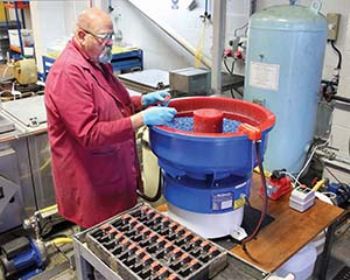
Winning a contract to machine large batches of two aileron parts from solid aluminium for the Airbus A320 presented Gloucestershire sub-contractor Norman Precision (
www.normanprecision.co.uk) with the problem of how to finish these complex components economically, as they require a large amount of hand deburring.
The solution was a 60-litre bench-top vibratory finishing bowl, which has automated part of the finishing process. It was supplied by Bletchley-based PDJ Vibro Ltd (
www.pdjvibro.co.uk).
Machining of the aileron components is completed in one hit on a Mazak Integrex five-axis turn-mill centre; and while a third of the cycle time is consumed by in-cycle deburring of specific features on the outside with a milling cutter, some of the manual deburring required on the outside has been replaced by processing in the vibratory bowl, saving 20min of hand-finishing per component.
The flashing on the inside still has to be removed by hand, as access for the mill is restricted.
A number of other parts produced at the sub-contractor’s Stonehouse factory are now similarly deburredautomatically. One is a stainless-steel component that was previously put out for bead-blasting. This is an on-going job for a single customer, and the monthly saving on sub-contract finishing is substantial.
An additional benefit is that the component is now produced entirely in-house, so the lead time has been reduced by about a week, and the company’s control over the contract is total.
Kevin Norman, managing director of Norman Precision, said: “Based on savings in the production of these two components alone — the aluminium aileron part and the stainless-steel component — the capital cost of the PDJ Vibro vibratory bowl will be recouped in less than six months from the date of purchase.”
Another job on which savings are being made is a pneumatic manifold for an aircraft. Produced from solid aluminium in two operations on a turn-milling machine, this features internal holes that intersect at compound angles, creating some heavy burrs that need to be removed manually afterwards.
However, the previous 15min required to hand-deburr the exterior has been replaced entirely by vibratory finishing of the components — six at a time in a 45min cycle.
Bob Savory, Norman Precision’s operations manager, said: “It means that our finishing specialist can concentrate on the exacting job of removing the internal burrs and complete the work while the next part is being machined on the turn-mill centre.
Another advantage is that the patina on the outside of components that have undergone vibratory finishing is
better, providing a more consistent mark-free surface that improves the quality of subsequent nickel plating.
“Consistency of finish is also better, as the variability that inevitably results from human intervention has been removed. An error made during manual finishing that causes a part to be scrapped can take the profit out of the job; vibratory finishing greatly reduces this possibility.”
PDJ Vibro has recommended different sizes, geometries and grades of ceramic abrasive to optimise the processing of different materials and to discourage the ingress of media inside the components. To this end, the larger ports in components machined by Norman Precision are blanked off using plastic plugs.
An adjustable dosing pump injects metal-finishing compound into the bowl periodically (typically every 10sec), while a constant — albeit minimal — flow of cold water is maintained to lubricate the media and keep it and the components clean.
PDJ Vibro is providing on-going support by advising on the optimum methods for finishing new materials — such as thermoplastics — that the sub-contractor has been asked to machine.
For example, trials are currently in progress at the supplier’s technical centre in Bletchley to establish the best way to process PEEK in a vibratory bowl.